Music
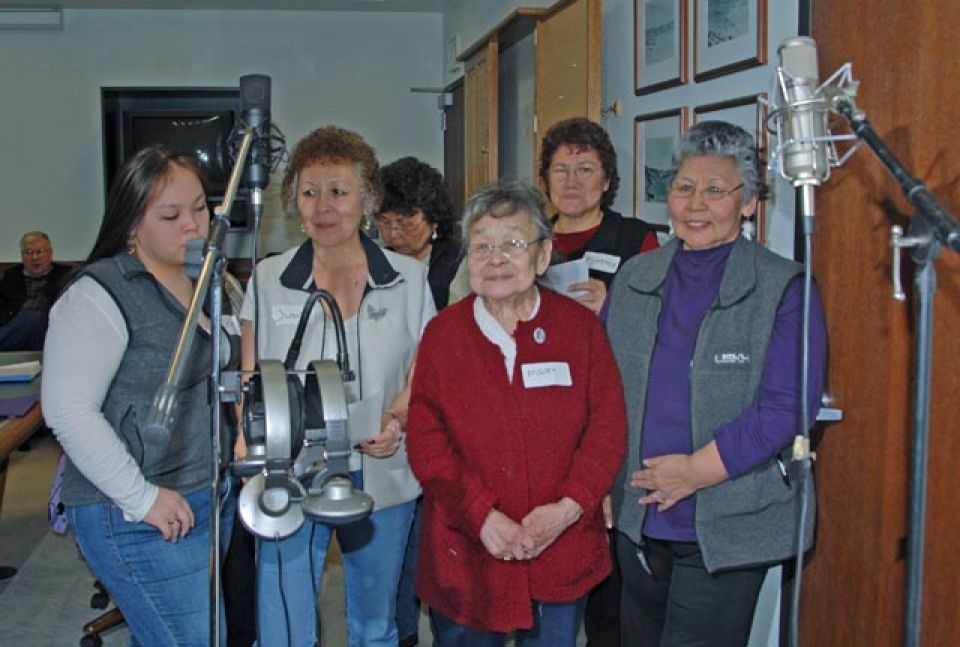
Alutiiq ladies record a song for the Generations Alutiiq Music CD.
In classical Alutiiq/Sugpiaq society, winter was a time of celebration. As the land froze, the social scene thawed. People gathered to eat, visit, and honor the spirit world. Music was a central part of every festival. Whistles, drums, rattles, and singing accompanied dance performances that invited spirits to the gathering and appealed to them for aid. By honoring the spirits of animals with songs and dances, Alutiiqs ensured future prosperity.
Today, singing is a favorite pastime in Alutiiq communities. People of all ages enjoy sharing a tune or learning a melody from an Elder. In addition to expressing emotion, songs are a form of storytelling. They record community history and express values. There are many different types of songs. People share everything from country-western tunes to Orthodox hymns, but they also remember traditional verses sung for hunting, curing illness, praising ancestors, dancing, and visiting.
Instruments

Drums
In the Alutiiq language, the word for drum and music are same – cauyaq, probably because drums were once the primary type of musical instrument.
Seated along the wall of the ceremonial house, drummers created a rhythm for dances and songs. Drummers beat their instruments with narrow, round ended sticks – kaugsuun, to create a deep resonant tone. Many drums had faces carved on their handles, perhaps to represent the spirit inside the instrument.
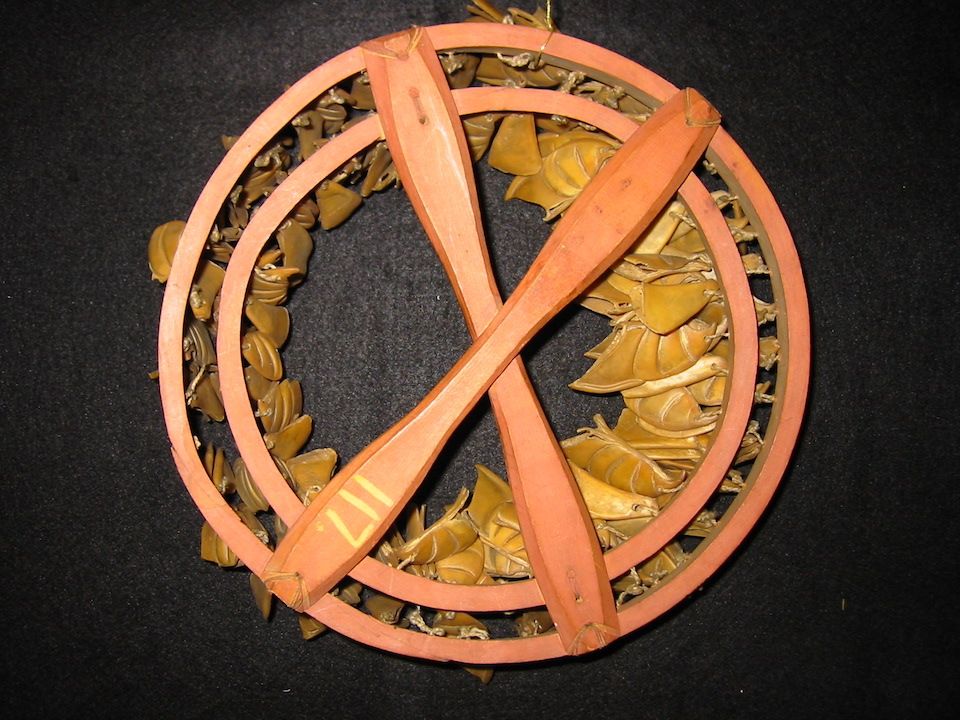
Rattles
While drums beat, Alutiiq dancers performed with rattles made from puffin beaks. Each rattle was about 12 inches wide and had as many as five concentric wooden hoops painted red and black and lashed to a cross-shaped handle. Craftsmen drilled small holes in each ring to attach clusters of puffin beaks.
Shaman, ritual specialists who communicated with the spirit world to heal the sick and predict the future, also performed with rattles. These were carved from wood, often in the shape of animals.
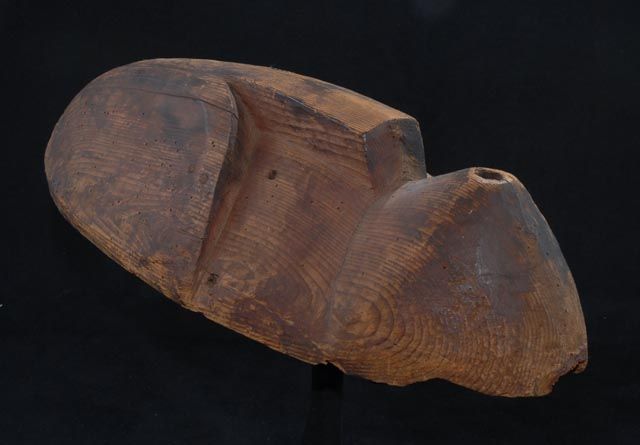
Whistles
Whistling was a dangerous and a tightly controlled practice connected with the spirit world. Dancers at winter festivals called to spirits in the sky and beneath the sea by whistling, which was said to mimic spirit voices. Some ceremonial masks had circular mouths to represent whistling.
Alutiiq people also associate whistling with evil and sickness. Shaman used whistles to conjure the spirit world when curing the ill or cursing rivals. Many Elders learned that spirits spoke first with whistles and then with words. Children were taught never to whistle for fear they would be harmed.
Elders Share Alutiiq Songs
Neresta taarimallria. – The louse whisked himself.
Taarirpaguarluni. – He whisked himself long and hard [showing off].
Ingqim yaamat ciqiluki. – The baby louse [nit] splashed water on the rocks.
Neresta atunguaruarluni. – And the louse sang to his little self [for the heck of it].
Staaman palayat arulatai. — Four boats are rocking/rolling.
Staaman palayat arulatai. — Four boats are rocking/rolling.
ARapat-i yuuluki aqumluci. — Sit down and remove your boots.
Kuugiaq/kuufiaq saagaRaq skaapamen liiluki. — Coffee and sugar, put them in the cupboard.
Katarsuartut. — They might fall.
Church Music
Russian colonization of the Kodiak Archipelago profoundly impacted the Alutiiq people. In this clash of cultures, Russian Orthodox missionaries defended the rights of Native people. Representatives of the Church established schools, cared for the sick, and fought mistreatment. Their concern for the Native community helped to build Kodiak’s Russian Orthodox community—introducing a new religion and its music. Many Alutiiq people remain devout followers of the Russian Orthodox faith, a spiritual path celebrated and reinforced with music.
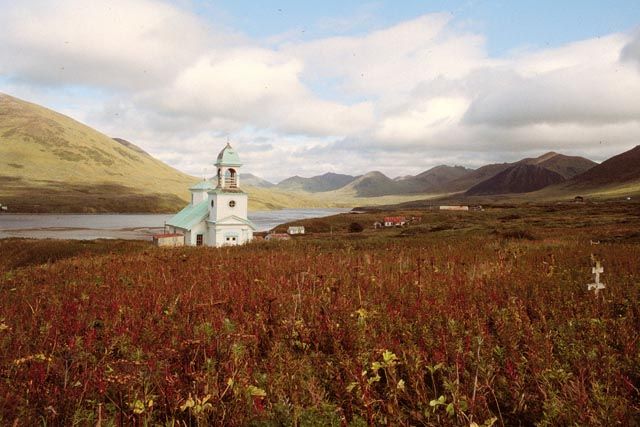
Services
The Orthodox faithful attend services every Sunday, where songs are an essential to worship. Church music cleanses the soul and helps listeners think of eternal values. It is a beautiful form of prayer.

Church Bells
Today, the onion domes of Russian Orthodox chapels grace Kodiak’s skies. Bells calls the faithful to worship, ring in celebration of special events, and toll in sorrow for those who have passed away. The sounds of church bells fill the air in every Alutiiq community.
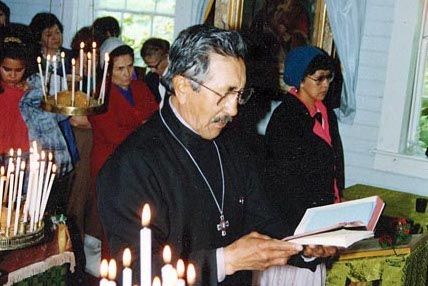
Hymns
Russian Orthodoxy clergy helped Alutiiq people learn church music by translating hymnals into the Alutiiq language. They wrote Alutiiq words phonetically, using Cyrillic characters. Many Alutiiq people also learned songs in Slavonic, the language of the church. Hymns remain an important part of the Alutiiq musical tradition.

Caroling
Christmas in Alutiiq communities comes on January 7th, following the Julian calendar that marks the Russian Orthodox year. In celebration, people participate in starring, a caroling procession that begins after evening church services. The faithful carol throughout their communities with a brightly decorated wooden star representing the Star of Bethlehem. At each home, the carolers sing in English, Slavonic, and sometimes Alutiiq, while a person spins the star. Then the singers receive food and hot drinks from their hosts. Each caroling session ends with a rendition of Many Years, the Orthodox hymn for blessings and long life.
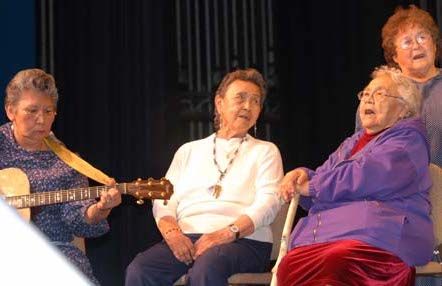
Songs of Faith
In addition to singing traditional hymns translated into the Alutiiq language, people compose original songs inspired by their faith. Irene Coyle wrote this spiritual tribute for voice and guitar.
He Had Mercy on Me / Nakllek’gkiinga
By Irene Coyle
He had mercy on me, my God. – Nakllek’gkiinga.
My God understood me. – Agautma kangircikiinga
He loved us, He loved us. – Qunuk’gkiikut, Qunuk’gkiikut. He had mercy on me, He loves me. – Nakllek’gkiinga Qunukaanga.
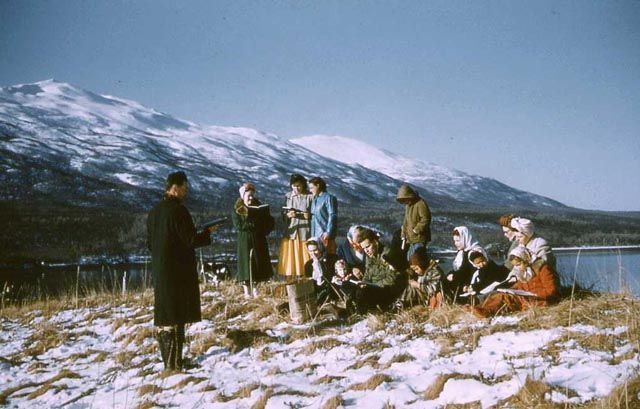
Other Faiths
Alutiiq people also learn liturgical music through their participation in other Christian faiths. Missionaries brought protestant traditions and church music to Kodiak in the early nineteenth century.
Community Musicians
In 20th century, as Alaska became industrialized and more closely connected to American society, music from around the world reached Alutiiq musicians through radio and recordings. Like the winter festivals of old, live entertainment was very popular. Alutiiq people taught themselves to play a variety of instruments and shared their talents at local events and dances. The marriage of Alutiiq people and Scandinavian immigrants also brought new music including polkas and schottisches from northern Europe.
Live entertainment faded after World War II as television became widely available. Today, a few musicians continue to play accordions and guitars, performing at special events like weddings.

Musicians
Alutiiq men taught themselves how to play the piano, mandolin, violin, banjo, guitar and harmonica. They learned popular songs from records, the radio, and other musicians, playing everything from Hank Williams songs to square dances.
The most famous musicians were accordion players, who used either small round accordions or larger twelve key instruments. Historic accounts suggest that accordion playing became popular in the 1890s, when the typical instrument cost about $3.50.
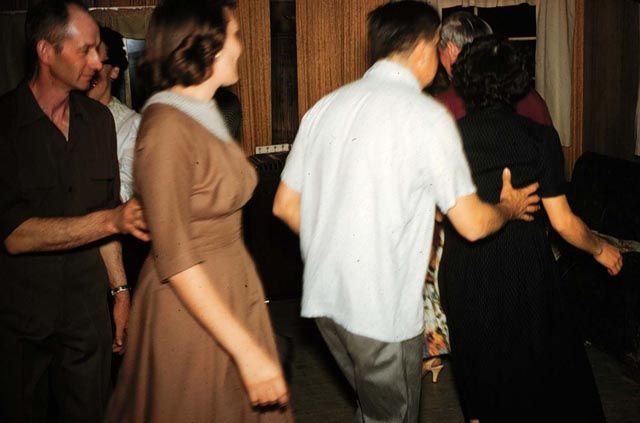
Dances and Dates
In the mid-20th century, dances were popular events in Alutiiq communities. Many villages held regular weekly dances. Fridays were popular hop nights, as Saturday evenings were reserved for religious practices. Music was a central part of community dances. Young men enjoyed playing their instruments for others. Putting on a show was also a good way to meet young women! Many people met their future spouses at these events.
During World War II, Old Harbor organized dances when the servicemen stationed on Sitkalidak Island came to town for supplies. Dancing was particularly popular with young people and some communities even operated dance halls from the 1930s to the 1950s.

Dance Halls
This Old Harbor building was a dance hall in 1950s, owned by the late Larry Matfay. Similar dance halls were found in Ouzinkie. Dances were usually held on Friday nights.
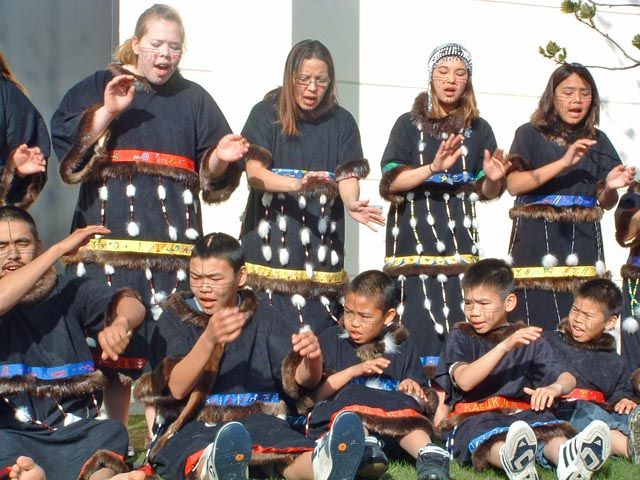
Today
Many communities have Alutiiq dance groups where youth learn songs and dances and share their talents through performances. Students build drums at art workshops and summer camps, learn Alutiiq songs as part of language lessons with Elders, sing Christmas carols during the starring celebrations held in Kodiak communities, enjoy modern music on iPods, and jam with drums and electric guitars! In 2007, Alutiiq people of all ages produced Generations, an Alutiiq music CD, to preserve and share their musical heritage.
